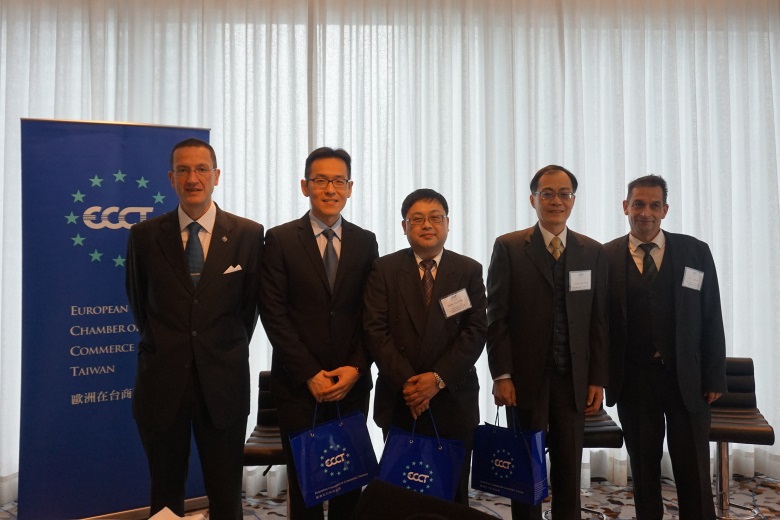Promoting Taiwan as a regional trans-shipment hub

The ECCT's Supply Chain committee hosted a lunch on the topic "Promoting Taiwan as a regional trans-shipment hub - Adapting to supply chain disruptions and trade wars". The event featured the following speakers: Wang Yu-ming, Section Chief, Department of Navigation and Aviation, Ministry of Transportation and Communications (MOTC); Huang Han-ming, Director, Customs Administration, Ministry of Finance and Chang Chao-chung, Section Chief, Bureau of Foreign Trade, Ministry of Economic Affairs (MOEA).
Following the imposition of tariffs on Chinese goods by the United States in July 2018 many companies operating in China began shifting production to other countries, presenting both a threat and an opportunity for Taiwanese manufacturers. At the event, speakers from various government agencies addressed the prospects and challenges facing Taiwan to become a hub for the final assembly and place of origin of a variety of products destined for export and the related challenges and opportunities for players in the shipping and logistics industry.
In his presentation Wang Yu-ming said that Taiwan could leverage its Free Trade Zones (FTZ) as regional trans-shipment centres in response to supply chain disruptions resulting from US-China trade tensions.
Taiwan is the most important transit point for connecting East Asia, China and North America. Taiwan Taoyuan International Airport (TTIA) has a total of 80 destinations and 1,384 flights per week to seven major western Pacific cities (Hong Kong, Singapore, Manila, Shanghai, Tokyo, Seoul, and Sydney). Taiwan’s four main ports have a total of 270 shipping routes globally. From the largest port, Kaohsiung, the average sailing time is around 53 hours to the five major ports in the Asia Pacific region (Singapore, Tokyo, Shanghai, Manila and Hong Kong).
116 enterprises are currently operating in Taiwan’s FTZs (in six ports plus TTIA). Each port has specific industry priorities. For example, Taipei Port is focused on automotive logistics while TTIA is focused on processing high technology products. Enterprises operating in FTZs receive a number of benefits including preferential rates for customs duties, commodity tax, business tax and “profit-seeking enterprise” income tax.
In order to provide enterprises with multiple re-export options, an efficient, low-cost re-export environment has been constructed, which is conducive to dealing with loose cargo (even in small volumes) from neighbouring countries to Taiwan, which can be consolidated before re-exporting. In recent years, the addition of a postal channel in FTZs aims to boost Taiwan’s attraction as a cross-border e-commerce trans-shipment hub with the aim of becoming a gateway of commerce between ASEAN countries, New Zealand, Australia and Europe.
Taipei Port and Pingtan Port in China’s Fujian Province currently have six round-trip ocean express shipments per week, taking just 2.5 hours per trip. Given that it takes just 25 minutes to travel from Taipei Port to TTIA, this route is attractive to multinational companies operating on both sides of the Taiwan Strait.
In his presentation Huang Han-ming noted that transit and trans-shipment customs procedures had been simplified in order to promote trade facilitation while regulations have been loosened and transparency increased in order to ensure predictable market access conditions. For example, for certain categories of goods (foreign goods in transit to other customs areas and foreign goods to be trans-shipped for export), no longer have to be declared. Moreover, procedures have been simplified for Multi-country Cargo Consolidation (MCC) and a one-stop customs clearance process has been put in place, shortening the time and reducing the cost of customs clearance.
Referring to a recommendation in the Supply Chain committee’s 2019 Position Paper to reduce the costs of setting up a logistics centre in Taiwan, the speaker made the point that many of the functions of a logistics centre can also be performed in a general bonded warehouse, for which establishment costs are much lower.
In his presentation Chang Chao-chung spoke about Taiwan’s precautions and trade measures for determining the country of origin. In the wake of the US’s tariffs on goods originating from China, the determination of the country of origin could mean a 10% difference in price at present. If the Trump administration follows through on its threat to raise the tariff to 25% on some goods, the issue becomes even more important.
For products to be determined as originating from Taiwan, they must meet the requirement of having been “substantially transformed” (processed or manufactured) in Taiwan. Taiwan has assigned specific tariff number codes to differentiate raw materials from processed goods. According to the speaker, substantial transformation is indicated by the first six digits of the tariff number of the product (showing that it is different from that of the raw material it was made from), added value exceeds 35% and there is a specific production process. Under this definition, simple processing does not constitute substantial transformation. As such, goods subject only to preservation or storage, packaging, additional marking or relabelling, assembling or mixing in Taiwan, cannot be regarded as “Made in Taiwan”. Taiwan has measures in place to prevent transhipment violations.
